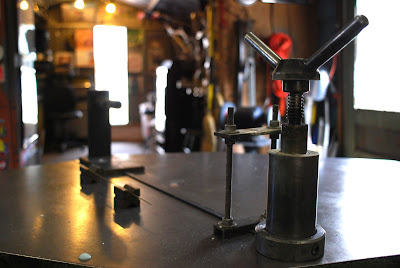First thing in the morning was more tower practice to prepare for some real brazing, and to warm up from the snow that had been falling in flurries outside. My towers have improved quite a bit, both in appearance and strength (they passed the hammer test this time!) and I feel like I'm getting the rhythm of brazing. After an hour of practice it was time for some serious work on the tubes for the main triangle.
 |
| Noticed this frame this morning - look at how the down tube extends past the bottom bracket and hugs the wheel. This is for aerodynamics - Mr. Yamaguchi tests his frames with riders in a wind tunnel! |
 |
| Nicely drilled and dremmeled! |
 |
| The surface, or alignment table. Crucial to frame building, it's currently set up to check our seat tubes against the bottom bracket and to tack them together. |
 |
| Currently tacked! The white gunk is flux, or as Mr. Yamaguchi puts it: "Your best friend and your worst enemy." |
 |
| Internally brazed. It might not look like much, but the inside of the seat tube is now reinforced, guaranteeing the frame will be strong and the fillet brazed joints won't fail. |
Letting the tubes cool, the next step was to work more on the top tube. This gets tricky, as the next miter needs to be exact, or the top tube won't be the right length. The miter also has to be at the correct angle, and line up with the other miter at the opposite end of the tube. No pressure or anything. First though, to ensure accuracy, Mr. Yamaguchi showed us how to find the centerline.
 |
| Checking the alignment of the top tube against the seat tube. |
 |
| It might not look like much, but these tools and setup are absolutely crucial to a good frame. One millimeter off, and the frame will not function or ride properly. Precision is key. |
I was barely finished with my last miter (about a millimeter left) when it was time to call it a day. Time flies when you're building frames, but working too long and getting tired can cause you to make small mistakes that can mess up the frame, so home we all went to rest up before tacking the rest of the main triangle tomorrow.
 |
| Included just because Suntour Superbe Pro is awesome. |

No comments:
Post a Comment
Tell me your bike related thoughts!